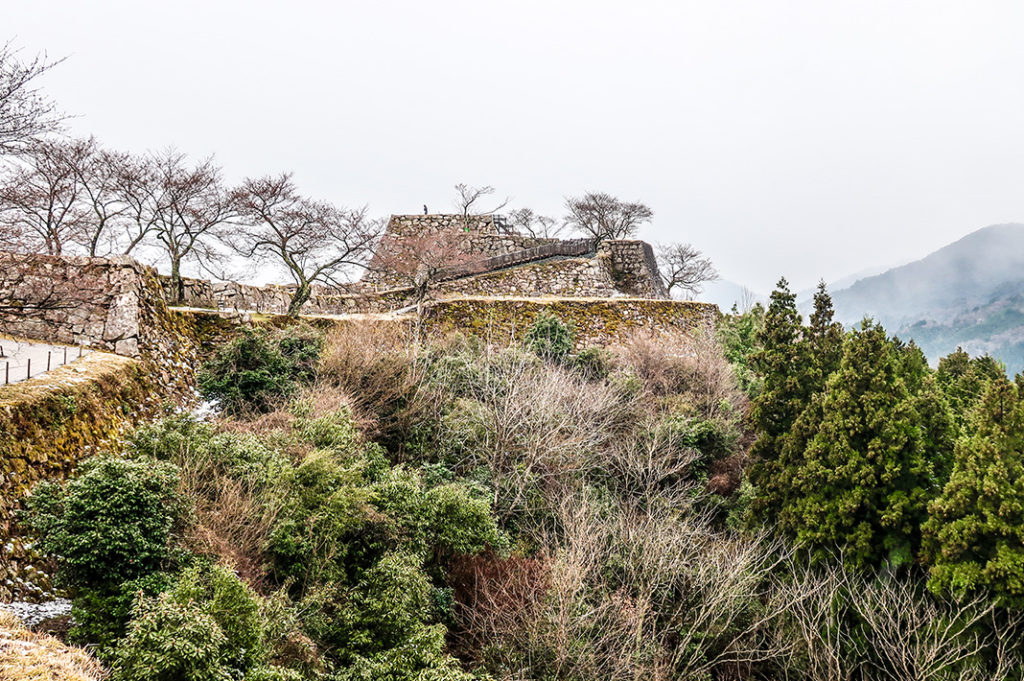Often billed as The Machu Picchu of Japan, the ruins of Takeda Castle are perched precariously on the top of a mountain in Hyogo prefecture. In the early morning, blankets of clouds roll in and obscure the base of the structure. The castle appears to fly, giving the structure its other nickname: The Floating Fortress.
Although the castle was a bit out of our way, the prospect of a visit proved irresistible. After leaving Kyoto, we took the train to Asago City and checked in to a cheap business hotel for the evening. Our plan was to get up and out early so that we could reach the castle before noon.
Getting In and Up
Whether you’re coming from Tokyo or Kyoto, you’ll most likely reach Takeda by heading to Himeji station first. From there, trains run to Takeda along the JR Bantan Line via a transfer at Teramae Station. The trip takes approximately 100 minutes. It’s best to book a room the night before visiting the castle, as the ruins offer the best views early in the morning.
If you’ve come to Takeda Castle with Instagram in mind, you’ll most likely want to visit between October and December. These are the foggiest months and the most likely to produce the sea of clouds that make the castle appear to float. You’ll also need to wake up early, as the clouds begin to dissipate a couple hours after dawn. A local tour guide can drive you around in the early morning and take you to the best vantage points.
Because of the struggle an early morning presented, we opted to skip the long-distance photography. Instead, we called a taxi and headed straight over to the base of the mountain. Those that want to avoid a hike, can drive all the way to the top. Otherwise, a mountain path takes hikers from Takeda Station to the ruins in about 20 minutes.
The walk is not particularly arduous and should present little challenge for even amateur hikers. It runs through a dense forest with a few rest stations along the way. The walk is also a quiet one. Other than a single hiker exiting the trail when we began, we were the only ones on the trail.

The View from the Top
Takeda castle was built by a local lord under the name of Izushi Castle in 1441. However, towards the end of the Sengoku period (Age of the Warring States), Hideyoshi Toyotomi launched an attack on the castle and conquered the fortress. Under the protection of multiple lords throughout various conflicts, a fire eventually broke out in the castle town. The ruling lord was accused of starting the fire and ordered to kill himself. Remaining inhabitants fled the castle in 1600, and it gradually fell into ruin.
Today, there is not much of the castle’s interior left to see, but a tour around the castle grounds gives visitors an idea of how the castle was laid out. Large stone foundations slope upwards to a series of plateaus that once housed the castle’s lords and retainers. From here there is little to obstruct your view, and on a clear day, you can get a full view of the surrounding mountains and valleys. Several volunteers maintain the site and can give you tips on where to get the best pictures.
Around Takeda
We were headed down to the city of Marugame in Shikoku that day, so there wasn’t much time for additional sightseeing. However, after discovering that the next train wouldn’t leave for another hour, we decided to grab some food. It was early on a weekday, and most of the stores on the main street were closed. After a bit of searching, we discovered a small restaurant serving standard Japanese lunch fair.
After tucking into a bowl of curry udon, we still had some time to kill. Fortunately, a nearby tourist center houses a small free museum that details the history of the castle and surrounding area. This kept us occupied for the remaining 20 minutes until our train arrived. Boarding the train, we began the series of transfers that was quickly becoming routine.
Name: Takeda Castle
Address: 169 Takeda, Wadayama-cho, Asago-city, Hyogo
URL: https://www.city.asago.hyogo.jp/kankou/eng/TakedaCastle.html
Post by Japan Journeys.